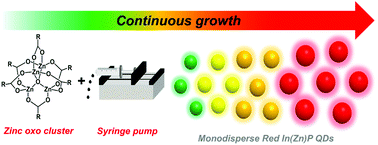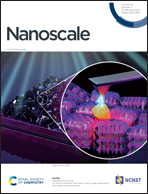Highly luminescent red-emitting In(Zn)P quantum dots using zinc oxo cluster: synthesis and application to light-emitting diodes†
Abstract
Despite the importance of separating nucleation steps from growth steps for the production of monodisperse highly luminescent In(Zn)P quantum dots (QDs), the practical implementation of this strategy is hindered by the high reactivity and fast depletion of conventional P precursors. This problem can be mitigated through the use of (i) Zn oxo clusters, which effectively regulate the kinetics of QD growth and prevent the fast depletion of conventional P precursors in the nucleation step, or (ii) seed-mediated continuous growth methods, which avoid secondary nucleation in the growth step and yield red-emitting InP QDs. Herein, we combine approaches (i) and (ii) to synthesize red-emitting In(Zn)P QDs with a high photoluminescence quantum yield (>93%) and a low emission bandwidth (full width at half maximum = 38 nm), revealing that our strategy hinders the carboxylate ketonization-induced generation of byproducts and suppresses the surface oxidation of In(Zn)P QDs during growth steps. The prepared In(Zn)P QDs are used to fabricate QD light-emitting diodes with a maximum brightness of 1164 cd m−2 and an external quantum efficiency of 3.61%. Thus, our results pave the way to the replacement of toxic Cd- and Pb-based QDs with more eco-friendly Zn- and In-based analogs for a variety of applications.

- This article is part of the themed collection: Quantum Dots: A Nanoscience Nobel Prize


 Please wait while we load your content...
Please wait while we load your content...